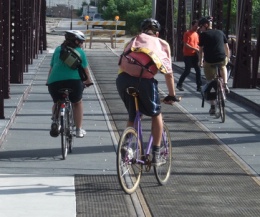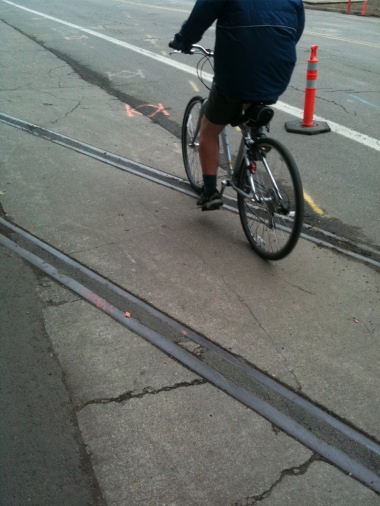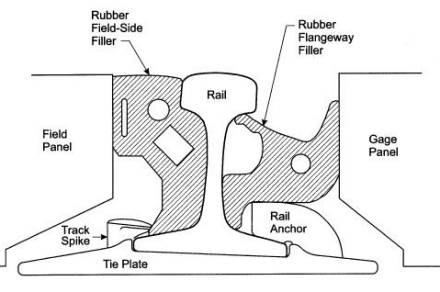
are filled with rubber so bicycle riders
can roll over them without worry.
(Photo: Steven Vance)
As we continue to discuss the ongoing problem of streetcar tracks causing people to crash while bicycling in Portland, I thought it might be helpful to share some potential solutions.
Many of the current issues (track-straddling on the Lovejoy ramp, tracks in the curbside shoulder (former bikeway) on the MLK/Grand couplet, the craziness in the Pearl District) have to do with a new streetcar line not that’s not even slated to open until fall of next year. However, much of the track is already in the street and has already claimed a lot of bike-riding victims.
The way I see it, PBOT and Portland Streetcar Inc., (the private non-profit that builds and operates the streetcar under City contract) must look to some interim fixes in the short-term and a more permanent solution in the long term.
Since there are tracks in the ground right now and people are crashing in them, why not fill the tracks with a temporary material that can be removed later? Activists with the non-profit Active Right of Way have suggested something as simple as gravel to fill the track gaps. While riding down in South Waterfront the other day, I noticed rail tracks that had been filled in with pavement.

This seems like a cheap and easy solution that might prevent some bloodied bodies and broken bones until streetcars actually start running on the system.
A more long-term solution would be some sort of rubber-filled flangeways. The basic idea is that the rubber allows bike tires to move over the flanges without incident, but the weight of a streetcar depresses the rubber. Once the streetcar passes, the rubber rises back up again. Check the drawing below (which came from this webpage)…
Chicago resident and urban planner Steven Vance has extensively documented the challenging bike/streetcar track issue as well as his city’s use of such rubberized trackways on the Cherry Avenue Bridge. He has even made a video showing a bike riding over the tracks…
After someone shared Vance’s photos and information with me the other day, I forwarded it to local streetcar project officials. It wasn’t the first they’d heard about rubber-filled flangeways, but they said they’ll get in touch with the maker of the product to see if its application is feasible in Portland (one big difference is that the Cherry Avenue Bridge isn’t a major rail corridor – it serves only a few rail trips a month).
Streetcar and bicycling officials at PBOT have said in the past that rubber-filled flangeways won’t work in Portland, but as the injuries and crashes mount, perhaps they’ll give them another look (or perhaps work with the manufacturer to create a product that meets Portland streetcar needs).
The way I see it is, doing nothing is not an option. The tracks are in the ground and people continue to get hurt. The problem has been extensively documented and has existed for years without any significant action from streetcar or city officials (they’ve known about this issue since as far back as 1996!).
Like I’ve said in the past, imagine if this traffic hazard occurred in some other context. Would PBOT really just continue with business as usual while people incurred serious injuries due to an obstacle in the public right-of-way?
Similar to many transportation issues we grapple with, we don’t lack solutions, we lack the creativity and will to seek them out and implement them.
Stay tuned for more streetcar track/bicycling coverage.


